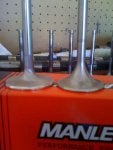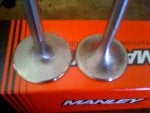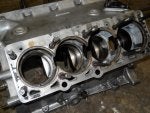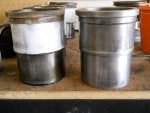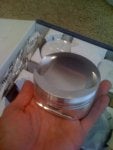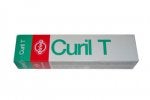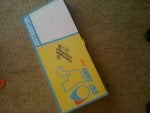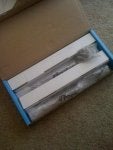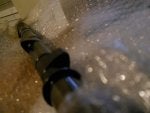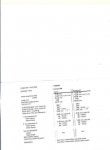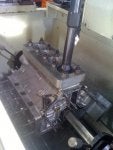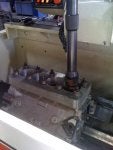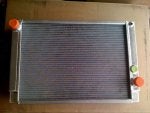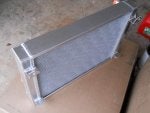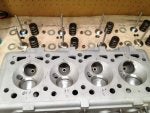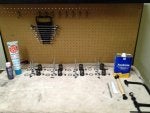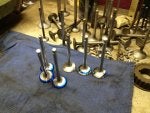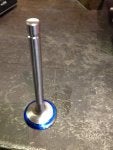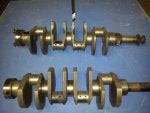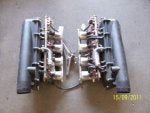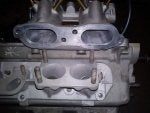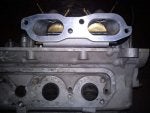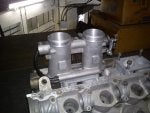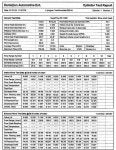Hi everyone. Thought I would make it known what I am up to here and throw some pics up.
The idea is to install a 360 crank (79mm stroke) into a 2v 308 block. A little modification is required, but to my knowledge it's not a ton as the crank spins freely in the 308 block on its own. The liners were bored and honed with torque plates to 83mm. Final capacity is just a bit over 3.4L.
Upgraded cams from Cat Cams in Belgium with 10.75mm lift and around 248 dur @ .050. I went with advice from Steve Dermijian and opened the intake valve size to 44mm as this is what he did for Nick's engine. I also used more of a nail head style valve which also reportedly helps things quite a bit. Lastly, the intake valve seats were replaced with larger OD and ID seats and the bowls were blended to accomodate the step in the ID the new valve seat creates. Flow is reportedly 12% better yet I am still awaiting the flow sheet to confirm this. I guess most of the gain is made over .150 lift with great flow present at .350-.400 lift.
The new cams use a radical slope and we collectively believed the stock valve seat pressure was not up to the task of handling this. The stock springs use around 60lbs seat pressure with 200lbs at only .350 lift (new cams are (.425 which would put stock springs at about 230lbs which is too high IMO)) from the seat, meaning these springs have a very high spring rate. I am going with a spring which uses a bit less rate yet is a longer spring so I can have a bit more seat pressure yet about the same nose pressure. Seat pressure is set to be approx 85lbs with 220lbs at the nose, and the springs of course have plenty of room before coil bind opposed to the stock springs which would really be pushed about to capacity if I used them with this cam. These new springs are also a good 20g lighter each.
Pistons are done from JE (10.5:1 with gapless top rings)
all machine work is completed (heads, block, line bore, flywheel surface, rods resized)
new clutch
new aluminum radiator
new high torque starter
ARP rod bolts
I will probably go to injection later, but for now I will stick with carbs and run ignition timing from a 36-1 trigger wheel and a simple CPU (MJ unit) until I swap to injection.
Case halves are going to be sealed up using the Porsche 911 crowd sealer of choice, namely 3bond 1194, and then Elring's Curil T for pretty much everything else.
Anyway, just waiting for the crank to show up on the boat from South Africa. The machine work can then get cracked out by our very own maistro of the lathe and Bridgeport, Mark, then of course I can throw this thing together.
The idea is to install a 360 crank (79mm stroke) into a 2v 308 block. A little modification is required, but to my knowledge it's not a ton as the crank spins freely in the 308 block on its own. The liners were bored and honed with torque plates to 83mm. Final capacity is just a bit over 3.4L.
Upgraded cams from Cat Cams in Belgium with 10.75mm lift and around 248 dur @ .050. I went with advice from Steve Dermijian and opened the intake valve size to 44mm as this is what he did for Nick's engine. I also used more of a nail head style valve which also reportedly helps things quite a bit. Lastly, the intake valve seats were replaced with larger OD and ID seats and the bowls were blended to accomodate the step in the ID the new valve seat creates. Flow is reportedly 12% better yet I am still awaiting the flow sheet to confirm this. I guess most of the gain is made over .150 lift with great flow present at .350-.400 lift.
The new cams use a radical slope and we collectively believed the stock valve seat pressure was not up to the task of handling this. The stock springs use around 60lbs seat pressure with 200lbs at only .350 lift (new cams are (.425 which would put stock springs at about 230lbs which is too high IMO)) from the seat, meaning these springs have a very high spring rate. I am going with a spring which uses a bit less rate yet is a longer spring so I can have a bit more seat pressure yet about the same nose pressure. Seat pressure is set to be approx 85lbs with 220lbs at the nose, and the springs of course have plenty of room before coil bind opposed to the stock springs which would really be pushed about to capacity if I used them with this cam. These new springs are also a good 20g lighter each.
Pistons are done from JE (10.5:1 with gapless top rings)
all machine work is completed (heads, block, line bore, flywheel surface, rods resized)
new clutch
new aluminum radiator
new high torque starter
ARP rod bolts
I will probably go to injection later, but for now I will stick with carbs and run ignition timing from a 36-1 trigger wheel and a simple CPU (MJ unit) until I swap to injection.
Case halves are going to be sealed up using the Porsche 911 crowd sealer of choice, namely 3bond 1194, and then Elring's Curil T for pretty much everything else.
Anyway, just waiting for the crank to show up on the boat from South Africa. The machine work can then get cracked out by our very own maistro of the lathe and Bridgeport, Mark, then of course I can throw this thing together.


